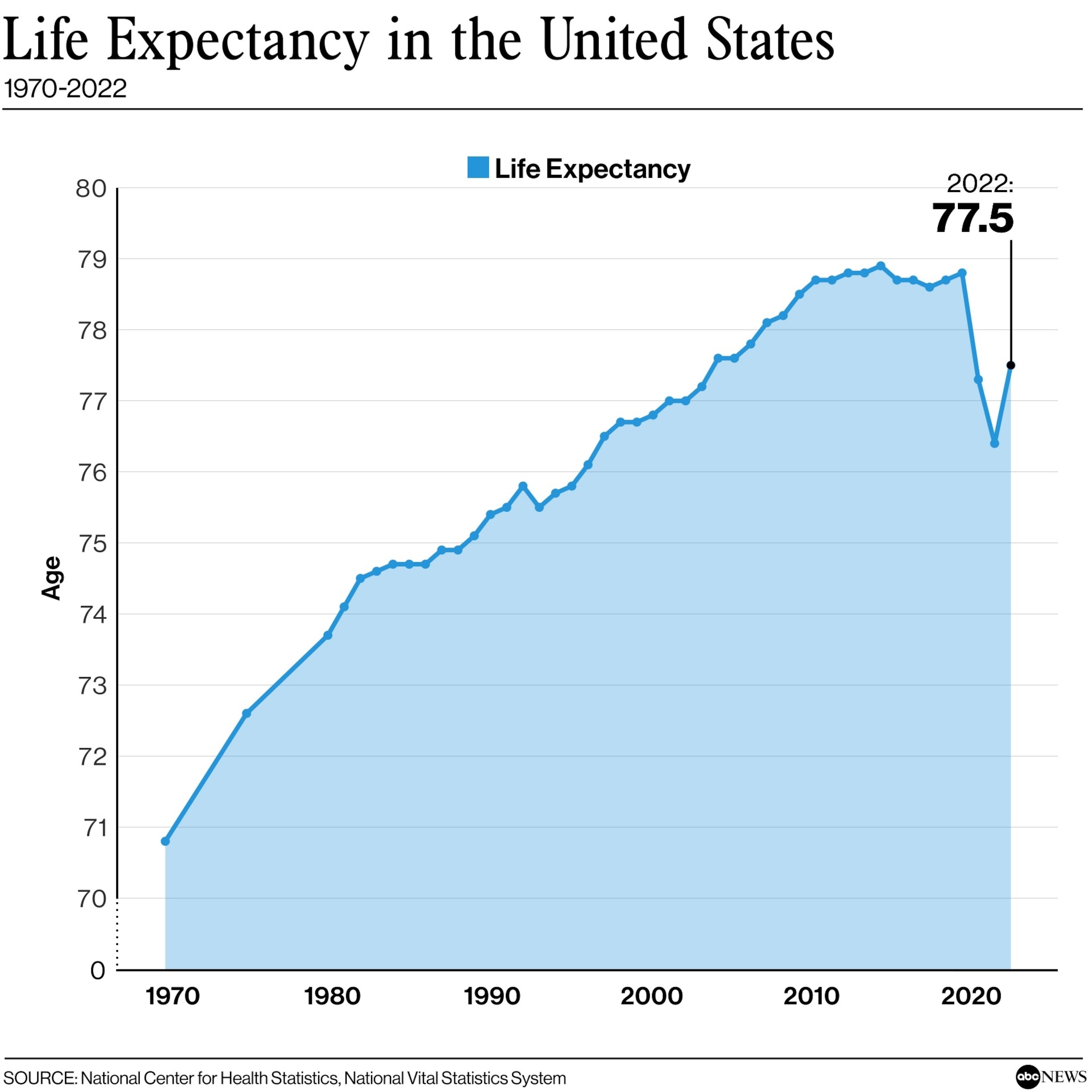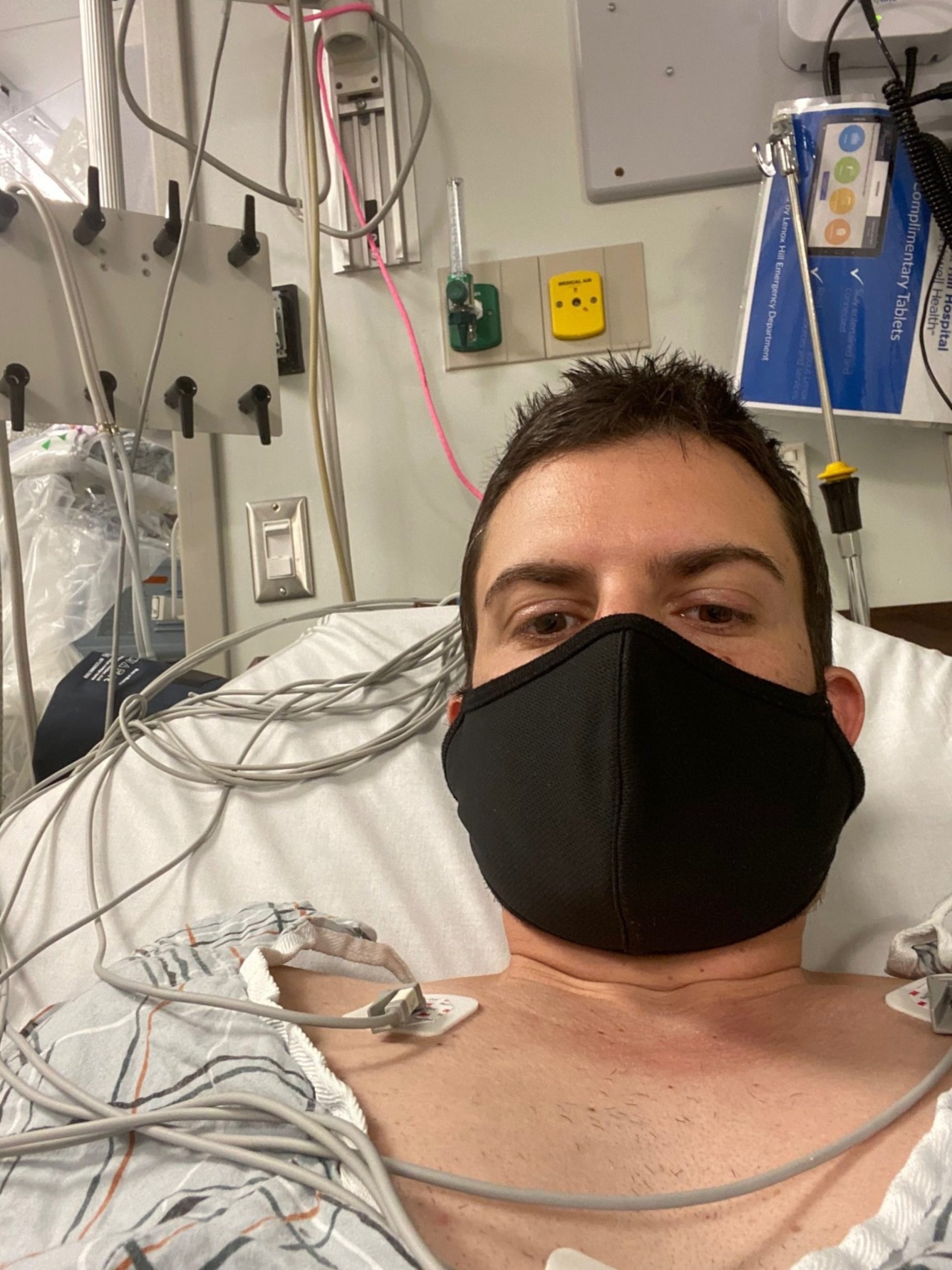Life expectancy in the United States increased in 2022 after two years of decline, according to new final federal mortality data.
In a report published early Thursday by the Centers for Disease Control and Prevention’s National Center for Health Statistics (NCHS), data showed life expectancy at birth was 77.5 years in 2022.
While life expectancy hasn’t reached pre-pandemic levels, it marked an increase of 1.1 years from 76.4 years in 2021.
In total, there were 3.27 million deaths recorded in the U.S. in 2022, about 184,374 fewer deaths than recorded in 2021.
The death rate in the U.S. decreased from 879.7 deaths per 100,000 in 2021 to 798.8 in 2022, a 9.2% drop.

Life Expectancy in the United States
National Center for Health Statistics, National Vital Statistics System
The report found the top 10 leading causes of death stayed the same from 2021 to 2022 but some causes changed ranks. Heart disease and cancer remained the two leading causes of death, respectively.
COVID-19 fell to the fourth-leading cause of death in 2022 while unintentional injuries took the number three spot.
Additionally, the number of deaths for which the virus was the underlying cause of death dropped by 55.3% from 416,893 in 2021 to 186,552 in 2022.
All of the top 10 leading causes of death saw a drop in death rates except kidney disease — the ninth-leading cause — which increased by 1.5%, from 13.6 per 100,000 deaths in 2021 to 13.8 per 100,0000 deaths in 2022.
When broken down by sex, males and females saw roughly the same increase in life expectancy from 2021 to 2022 with males increasing by 1.3 years from 73.5 years to 74.8 years and females increasing by 0.9 years from 79.3 years to 80.2 years.
Every racial/ethnic group saw a decrease in death rates for both males and females. American Indian/Alaskan Native males had the highest death rates in 2022 but also saw the biggest drop in a year, decreasing 15.9% from 1,717.5 per 100,000 deaths to 1,444.1 per 100,000.
By age, death rates decreased for almost every age group except among children. The 1-4 age group saw death rates increase 12% from 25.0 deaths per 100,000 in 2021 to 28.0 per 100,000 deaths in 2022 and the 5-14 age group saw a 7% increase from 14.3 deaths per 100,000 in 2021 to 15.3 per 100,000 deaths in 2022.
A 2023 study found child and adolescent mortality rates had dropped due to decreases in childhood disease but have been increasing recently — primarily due to increases in homicides, accidental drug overdoses, car accidents and suicides between ages 10 and 19.
Meanwhile, infant mortality increased by 3.1% from 543.6 infant deaths per 100,000 live births in 2021 to 560.4 in 2022.

People visit the ‘In America: Remember’ public art installation near the Washington Monument on the National Mall, Sept. 18, 2021, in Washington, D.C.
Kent Nishimura/Los Angeles Times via Getty Images
Congenital malformations were the leading cause of infant death in 2022 followed by low birth weight; sudden infant death syndrome; unintentional injuries; maternal complications; cord and placental complications; bacterial sepsis of newborn; respiratory distress of newborn; intrauterine hypoxia and birth asphyxia; and diseases of the circulatory system, respectively. Additionally, the report said the top 10 leading causes of death accounted for 65.2% of all infant deaths in the U.S. in 2022.
It comes as a separate NCHS report, also released on Thursday, found rates of drug overdose deaths — despite quadrupling over the last two decades, becoming one of the leading causes of injury death in the U.S. — did not significantly change from 2021 to 2022.
Between 2021 and 2022, the death rate involving synthetic opioids other than methadone — such as fentanyl — increased by 4.1% from 21.8 per 100,000 to 22.7 per 100,000, while rates for deaths involving heroin, natural and semisynthetic opioids and methadone declined.
The Centers for Disease Control and Prevention (CDC) recently released a report indicating positive trends in US life expectancy and a decrease in COVID-related deaths in 2022. This news comes as a welcome relief to many Americans who have been grappling with the effects of the pandemic for the past two years.
According to the CDC report, life expectancy in the United States has increased by 0.1 years in 2022, reaching an average of 78.9 years. This marks a significant improvement from the previous year, when life expectancy had declined due to the impact of COVID-19. The increase in life expectancy can be attributed to a number of factors, including advancements in medical treatments, increased access to vaccines, and improved public health measures.
In addition to the rise in life expectancy, the CDC also reported a decrease in COVID-related deaths in 2022. The number of deaths attributed to the virus has dropped by 30% compared to the previous year, signaling a significant decline in the impact of COVID-19 on the population. This decrease can be attributed to the widespread availability of vaccines, which have proven to be highly effective in preventing severe illness and death from the virus.
While these trends are certainly encouraging, experts caution that the pandemic is not yet over and that continued vigilance is necessary to prevent further outbreaks. It is important for individuals to continue following public health guidelines, such as wearing masks in crowded settings and practicing good hand hygiene, to help prevent the spread of COVID-19.
Overall, the CDC report offers a glimmer of hope for a brighter future as the United States continues to navigate the challenges posed by the pandemic. With increased life expectancy and decreasing COVID-related deaths, there is reason to be optimistic about the road ahead. By staying informed and taking necessary precautions, we can work together to overcome this global health crisis and build a healthier, more resilient society.



